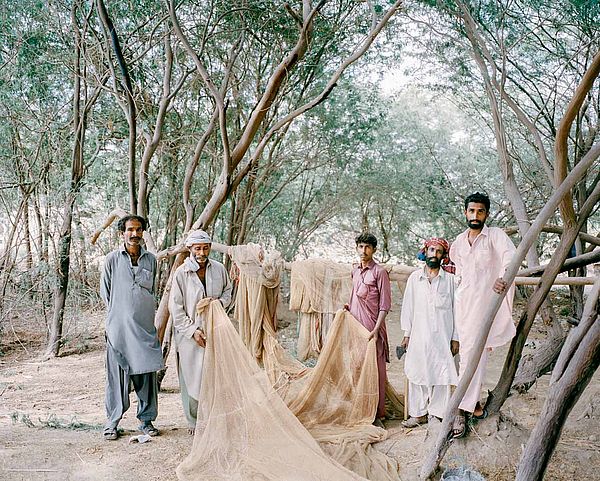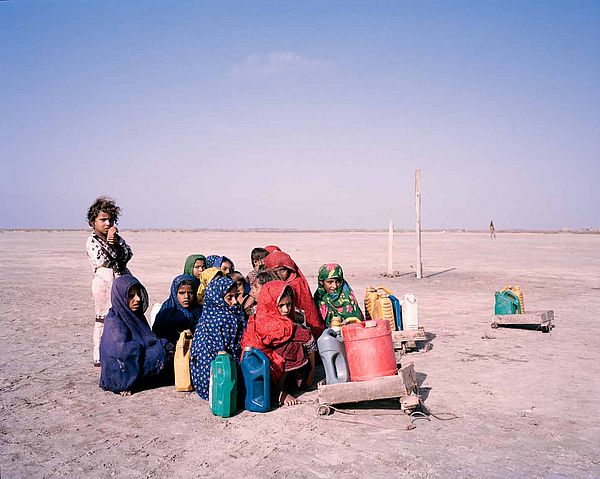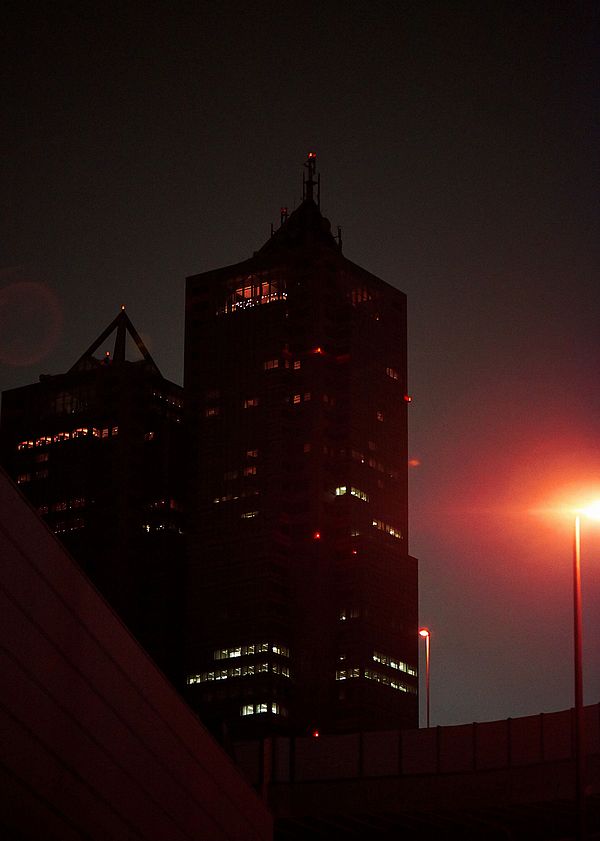Where Does the Future Take Space?
Saskia Sassen on Global Cities of the future
Cities around the world are not only increasing in number – their transformation also entails social consequences that are difficult to predict. While the middle class is becoming increasingly marginalized by these global cities, they provide fertile ground for a class that is steadily growing despite being completely underestimated in political discourse: as the power base of the powerless.

About Saskia
Saskia Sassen (New York) is a professor for sociology at Columbia University. The globalization theorist coined the term “Global City”.
headline
The large complex city, especially if global, is a new frontier zone. Actors from different worlds meet there, but there are no clear rules for that engagement. The historic frontier was in the far stretches of colonial empires and encounters were marked mostly by overt violence on the part of the invaders.
Today’s frontier zone is in our large, messy, global cities. That old historic frontier mostly no longer exists: major corporations and powerful governments have bought up or grabbed vast stretches of land in the Global South to extract what they need. In this process, millions of smallholders have been driven off their land. And the last remaining place where they can lay down their bodies is now in the region’s large cities of the Global South and, to some extent, the Global North – because these are spaces that cannot be fully controlled.
headline
If the original Bauhaus architects and thinkers were here today, would they be focused on this? I think most might say no. Let me argue that yes, they would. Why? Because this is one of the major processes happening across the world: massive expulsions of millions and millions of smallholders from their land. Today’s land and water grabs are one of the major factors repositioning the meaning of urban space and urban building in most of the Global South, even if not quite in Europe. But the pioneering imaginations and concerns of the Bauhaus project would have taken this in sooner or later.
“asset backed securities”
Saskia Sassen
Strategic for the Powerful and the Powerless
Cities are, ironically perhaps, strategic for both global corporate capital and the powerless. It is probably the modest middle classes and the older type of working classes who have lost ground in these cities, as their work and capacities are increasingly either not necessary for leading sectors or have been replaced by machines and lower-level workers; furthermore, both of these groups have some resources that allow them to consider the housing question in terms of dwelling, rather than as a power space or the only space where you can lay down your body because that is all you have left.
It signals the possibility of a new type of politics, centred in new types of political actors. Cities are complex systems. But they are incomplete systems. These features take on urbanized formats that vary enormously across time and place. In this mix of complexity and incompleteness lies the capacity of cities to outlive far more powerful but formal, closed systems. Thus, many a city has outlived governments, kings monarchies, the leading corporation of an era, and other instances of formal power. Herein also lies the possibility of making in a city – making the urban, the political, the civic, a history. Using this type of definition of a city, I would argue that a growing range of today’s dense built-up terrain, such as a vast privately owned office complex with multiple towers (and guards controlling access) is built density, but it is not about cityness. On the other hand, a working slum can have many of the features of a city, and indeed, some are a type of city – poor but deeply urban.
Headline
In this mix of incompleteness and complexity lies the possibility for the powerless to hack power in the city, in a way that they could not in a mine or in a plantation, as these are nowadays highly controlled spaces. In the past, mines and plantations were the spaces where those without power could organize – but not today, given the militarization of control in such settings. Today it is in our large cities that the powerless are able to make a history, a politics, a culture. And even if this happens at a local level, in their neighborhood, it still matters. They do not get empowered by the system, but they gain a kind of partial autonomy and the chance to make local economies, cultures and politics

When Urban Space Is Mined
The last few years have seen an increasingly alarming intervention by powerful actors that reduce buildings to nancial instruments. I think of this as the mining of built-up urban space. At its most acute, it reduces buildings to nancial assets, so that an empty building might be more valuable to its owners or investors than an occupied building. Why? Because an empty building can easily be transformed into “asset backed securities,” a powerful nancial instrument that can generate extraordinary
gains. The “asset” might be any bit of materiality of the building – enabling enormous exibility and options. Furthermore, it can be bought and sold on the global nancial markets far more easily than the actual building.
For now, the more common investment mode is to buy the building and make it work as a building (as of yet). These buildings are easy ways of laundering cash/profits obtained under dubious conditions. This is a long-standing practice across the world. Here the rise of a very large sector of high-income households and high-profit firms is the most common and visible mode through which a growing share of urban space is now built up as expensive, high-end space. This rapid rise of a fairly large, rich class of urban residents – going well beyond the top one per cent – is altering the urban condition in yet another way. It has raised the value of central city land and surrounding neighborhoods. A whole new global market for buying luxury buildings has developed over the last several years, which has further changed the situation for lower-income and increasingly also middle-class households.
In short, current conditions in global cities, in particular, are creating new structurations of power. This is not just “economic devel-opment”. It goes much deeper and begins to unsettle the deep logics of what we think of as the city, urban space, architecture as a benign event that can add much to the life of urban dwellers (and visitors).
From Modest Middle Classes
to the Poor
While the large, mostly modest middle classes are among the main losers in this new dynamic emerging in major cities, the low-income work-ing classes are growing in numbers. They are in high demand in a very broad range of sectors. The older, once thriving middle classes are being replaced by machines, digitization, out-sourcing, sta cuts in the public sector and more.
Our major cities are increasingly spaces for the rich and the “low-income”, even poor. Even if displaced to more marginal areas in these cities, the neighborhoods of those without power, of the poor, are spaces where they can develop their own economies and cul- tures. This brings with it operational and rhetorical openings for their concerns and their projects. They can develop elements of a local economy, cultural initiatives, mobilize politically – all initiatives and conditions far more dif- cult to develop in small, highly controlled towns where the middle classes are often dominant.
In large cities, the disadvantaged can become new types of actors. Such cities are spaces where those without power can make themselves present: in the richest neighbor-hoods where they are the indispensable domestic help, in the corporate center where they are indispensable service workers and so on. Thus, powerlessness can become complex in the city.
And this matters. They are thereby able to make a history, a politics, even if they do not become fully empowered. Thus, current conditions in global cities, in particular, are creating not only new structurations of power but also operational and rhetorical openings for types of actors who lack power but nonetheless have projects. One way of conceiving of some of this is as instances of urban capabilities. (I develop this argument in “Does the City Have Speech?” (Public Culture 25:2, pp. 209-221, April 2013.)

Hybrid Bases for Disruptive
Narratives
Thus, global cities are also strategic for those without power. It signals the possibility of a new type of politics, centered in new types of political actors. That is one instance of what I seek to capture with the concept of urban capabilities. It is not simply a matter of having or not having power. In the case of the powerless, it is a strategic space because the political goes well beyond routine voting and having to accept corporate utility logics, or the dominance of narratives that strengthen powerful actors. Urban space in powerful cities provides new hybrid bases from which to act.
There is yet another type of hacking of long-time orders that is taking place today. It is the hacking of well-established larger units, notably nationstates, that are beginning to lose the grip on domains where they once had considerable control. This is an important, even if partial and not always desirable change. In “Territory, Authority, Rights” (Princeton University Press, 2008) I identified a vast proliferation of such partial disassemblings and reassemblings that arise from the remix of bits of territory, authority and rights, once all ensconced in national institutional frames.
headline
One outcome we are seeing in city after city is the making of new kinds of informal politics. For instance, there is a kind of public-making work that can produce disruptive narratives and make legible the local and the silenced. Political work gets done this way: It becomes the work of making a new kind of contestatory public that uses urban space as a medium, a tool to hack power, even if does not bring power down.
The Occupy movements that arose in countries in very different parts of the world were momentarily disruptive but educational in the long-term. They rhetoricized inequality and provided a narrative to large sectors of the impoverished middle classes, usually a rather conservative/prudent sector. It has evolved as a politics that is making headway at the level of political speech and mobilization, not necessarily system change: Podemos in Spain, Syriza in Greece, the rise of a 70-year-old long-term socialist in the US appealing to all ages, but especially the young. The changes in Bolivia and Venezuela have been deeper still, encompassing a whole new vocabulary and governmental logic; less radical but still significant are Peru and Quito. All of these, across their di erences, and with varying levels of intensity, share a partial or full repudiation of politics as usual.

“urban space as a medium”
Saskia Sassen
A New Type of Urban Subject?
These diverse elements that are now part of the current situation in major cities across the world signal the possibility of making a new type of urban subject. In many ways, the subject I am thinking of has existed in cities across time and place. But it has mostly been somewhat rare. It is the urban subject that results from hacking ethnicity, religion, phenotype, inequality, physical disability. Old Baghdad and Jerusalem, industrializing Chicago in the early 1900s, 20th-century Berlin and Buenos Aires were such cities. This is not to deny the specific histories and geographies that generated what I like to call the “urban subject”.
The urban subject is at home with enormous differences of religion, ethnicity, wealth. A city’s sociality can bring out and underline the urbanity of subject and setting, and dilute more essentialist markers. It is often the need for new solidarities (for instance, when cities confront major challenges) that can bring about this shift. Urban space, especially a city’s center can hack our essentialisms as it forces us into joint responses, into crowded public transport, into highly mixed work situations, into public hospitals and universities, and so on. From there it can move us onto the appreciation of an urban subject, rather than more specific individual or group identities that might rule in a neighborhood.
The big, messy, slightly anarchic city enables such shifts. The corporatized city or the business park does not.

„Modest housing in highly valued central urban space“
Saskia Sassen
Back to the Bauhaus!
Centering social justice in building is potentially a powerful vector in urban space. I cannot help but think that at least some of what gave rise to the Bauhaus would have engaged today’s housing challenge along these lines. Building modest housing in highly valued, central urban space becomes speech – political speech. And that means it can be present even if the actual housing project fails, and it can stay alive as project, as possibility, as necessity.
As a complex but incomplete space, the city can bring together multiple very diverse struggles and engender a larger, more encompassing push for a new normative order. It enables people with di erent passions and obsessions to work together. But this is not enough in the current period, especially perhaps in the Westernized part of the globe – which includes much of Latin America and much of Africa. The escalating concentration of power and a certain kind of exhaustion of the social-democratic project that worked quite well in much of Europe is now also in a decaying condition there.
headline
There are no easy solutions. But coming back to the aspirational side of Bauhaus, we can see a lière that engaged the social question – not as a political, but as a building project. That makes it interesting as a mode of intervention in cities increasingly dominated by and geared towards the desires of the rich classes – which today account for up to 40 percent of households in many major cities.
[SS 2018]
This article was originally published in the second issue of the “bauhaus now” magazine.


